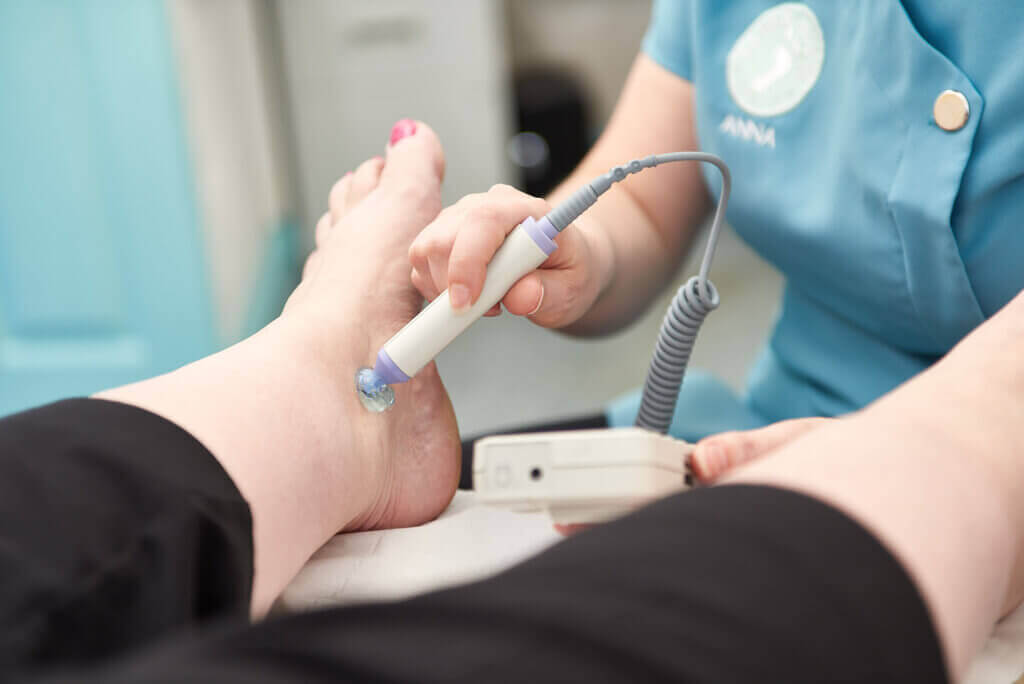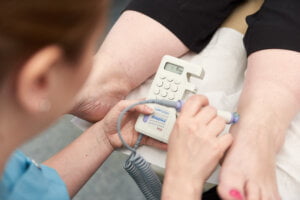
Vascular Disease Awareness Month
September is Vascular Disease Awareness Month. Let’s explain a little about vascular diseases and why they are important in Podiatry.
What is vascular disease?
The NHS website describes vascular disease as this – “Cardiovascular disease (CVD) is a general term for conditions affecting the heart or blood vessels. It’s usually associated with a build-up of fatty deposits inside the arteries (atherosclerosis) and an increased risk of blood clots.
It can also be associated with damage to arteries in organs such as the brain, heart, kidneys and eyes.
CVD is one of the main causes of death and disability in the UK, but it can often largely be prevented by leading a healthy lifestyle.”
Vascular Disease Awareness Month aims to improve knowledge and understanding of these conditions.

What are the types of vascular disease?
Vascular diseases can affect vessels in the heart, (causing heart attacks), the brain, (causing strokes), or peripheral arterial disease (PAD) affecting mainly the blood vessels in the lower limb. Vascular disease can also affect the aorta, which is the main blood vessel leading from the heart.
What does this have to do with Podiatry?
Peripheral arterial disease (PAD) is estimated to affect around 20% of those over 60, and around 20 million people world-wide.
As part of our clinical assessments, We, as podiatrists, carry out vascular checks on the lower limb. When you come in for your appointment, as well as treating your podiatric problems such as nails and skin lesions, we look at lots of other details, such as the skin colour, texture, temperature. These are all indicators of vascular health.
When we take your medical history we are also looking at vascular risk. Diabetes, high blood pressure, smoking, previous stroke, age for example are all vascular risk factors. All these things contribute to an increased risk of vascular disease. You may wonder why we ask all these questions in our assessment forms!
When we see new patients in our foot and ankle clinic with any of the above conditions, those are over 50, or any existing patients who present with new symptoms, we carry out a Doppler assessment of the feet.
We listen for the number of sounds detected in each pulse beat, and the quality and regularity of that sound.
A reduced number of sounds in each pulse beat may indicate reduced blood flow, caused by damage and narrowing to the arteries.
An irregular pulse can also be an indicator of cardiac problems such as atrial fibrillation. In these cases we carry out an assessment with our Kardia device (see our blog on this here)
If we detect reduced circulation or irregular heartbeats, we contact your GP for them to assess further and refer on to the appropriate hospital services.
By picking up reductions in circulation, identifying PAD and irregular heartbeats, we can help to reduce the risks of heart attacks, strokes and potential loss of limbs.
Why is the blood flow so important?
Good blood flow is essential for good foot health. Reduced blood flow to the feet can make skin very fragile, and cause wounds to develop which can be slow to heal. The building blocks for healing skin, growing nails etc. come from the blood supply.
It can also cause pain in the legs on walking or exercising as the reduced blood flow causes a reduction in oxygen supply to the muscles.
If you have any concerns about your lower limb circulation, if you suffer from diabetes, or pain in the muscles when walking for example, then visit your local HCPC registered Podiatrist for assessment and advice.
More information on vascular disease and Vascular Disease Awareness Month can be found here -
https://www.vascularsociety.org.uk/patients/conditions/7/peripheral_arterial_disease
https://www.bhf.org.uk/informationsupport/heart-matters-magazine/medical/peripheral-arterial-disease
https://www.nhs.uk/conditions/peripheral-arterial-disease-pad/
Frequently Asked Questions (FAQs)
The most common vascular disease is peripheral artery disease (PAD). It occurs when there is narrowing or blockage of the arteries that supply blood to the limbs, typically the legs. This condition can lead to symptoms such as leg pain or cramping during physical activity (claudication) and can progress to more severe complications if left untreated.
Vascular disease involves conditions affecting arteries and veins outside the heart and brain, causing reduced blood flow and potential complications like pain or organ damage. Examples include Peripheral Arterial Disease, and Deep Vein Thrombosis. Treatment varies based on the specific condition and severity.
Stage 4 vascular disease, often associated with peripheral artery disease (PAD), is characterised by:
1. Severe Symptoms: Includes pain at rest, even without physical activity.
2. Tissue Damage: Manifests as ulcers or wounds that are slow to heal.
3. Gangrene: Occurs due to severely restricted blood flow, leading to tissue death.
4. High Risk of Complications: Such as infections and amputation if untreated.
5. Treatment: Involves aggressive medical management, lifestyle changes, and sometimes surgical interventions to restore blood flow and prevent further deterioration.
The best treatment for vascular disease depends on the specific condition and its severity. Generally, treatments may include:
1. Lifestyle Changes: Such as quitting smoking, regular exercise, and a healthy diet to manage risk factors like high blood pressure and cholesterol.
2. Medications: To control symptoms and manage underlying conditions like hypertension or diabetes.
3. Minimally Invasive Procedures: Such as angioplasty and stenting to open narrowed or blocked arteries.
4. Surgical Interventions: For more severe cases, including bypass surgery to reroute blood flow around blocked arteries.
5. Vascular Rehabilitation: Programs to improve circulation, manage symptoms, and prevent complications.
6. Regular Monitoring: To assess progress and adjust treatment as needed. Treatment plans are personalised based on the patient's health, the type and stage of vascular disease, and their overall medical history. Consulting with a vascular specialist is essential for proper diagnosis and tailored treatment recommendations.
Anna Conway
BSc (Hons), MCPod, SRCh, PGcert Podiatry
Owner, Lead Podiatrist

